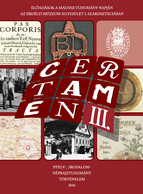Nagybánya városvezető elitje és az önkormányzati testület szerkezete (1569–1600)
The Governing Elite of Baia Mare (Nagybánya) and the Structure of the Local Government (1569–1600)
Author(s): Petra Mátyás-RauschSubject(s): Local History / Microhistory, Social history, 16th Century
Published by: Erdélyi Múzeum-Egyesület
Keywords: Baia Mare; local government; mining; guilds; town-minutes
Summary/Abstract: The study examines the leading groups of Baia Mare (Nagybánya) between 1569 and 1600. The most important source is the protocol of the town-minutes, that includes the names of the elected officials. Examining the elite of Baia Mare from the early modern period several basic conclusions may be drawn. Three groups belonged to the leading political stratum of the town: craftsmen, miners, and ‘other citizens’, who couldn’t be categorized. The group of the craftsmen had the most important effect on the town’s political life: although this stratum gave the most jurors and councilors to the government, at the end of 16th century their influence was driven back by many reasons. During this era the miners’ participation wasn’t significant in the leading staff of the town, in spite of the fact that Baia Mare was a well-known mining town, and – because of the presence of the mining chamber and the mint – it was the center of the mining administration. Although the lack of information stopped us to precisely categorize the members of the third group, that of the ‘other citizens’, “intellectuals” seem to represent this stratum, who had taken over the leading roles in the town from the craftsmen at the end of 16thcentury. The local government of Baia Mare consisted of two parts: the “inside” and the “outside” councils, who led the town’s life in the 16th and 17th centuries. Though, in the time of the chamber administration there was only one council elected, both of them were elected only after 1579.
Journal: Certamen
- Issue Year: 2016
- Issue No: III
- Page Range: 271-282
- Page Count: 12
- Language: Hungarian

